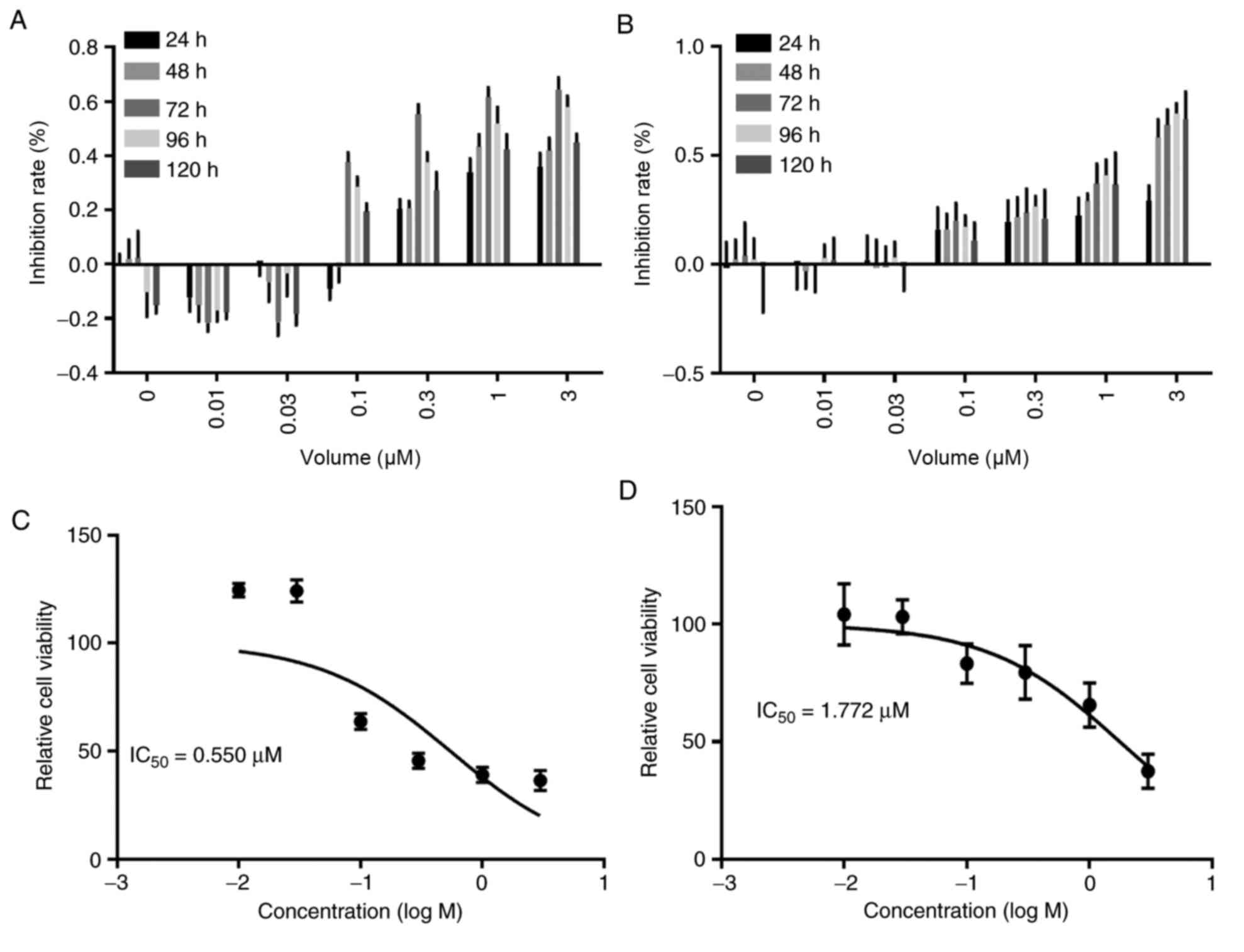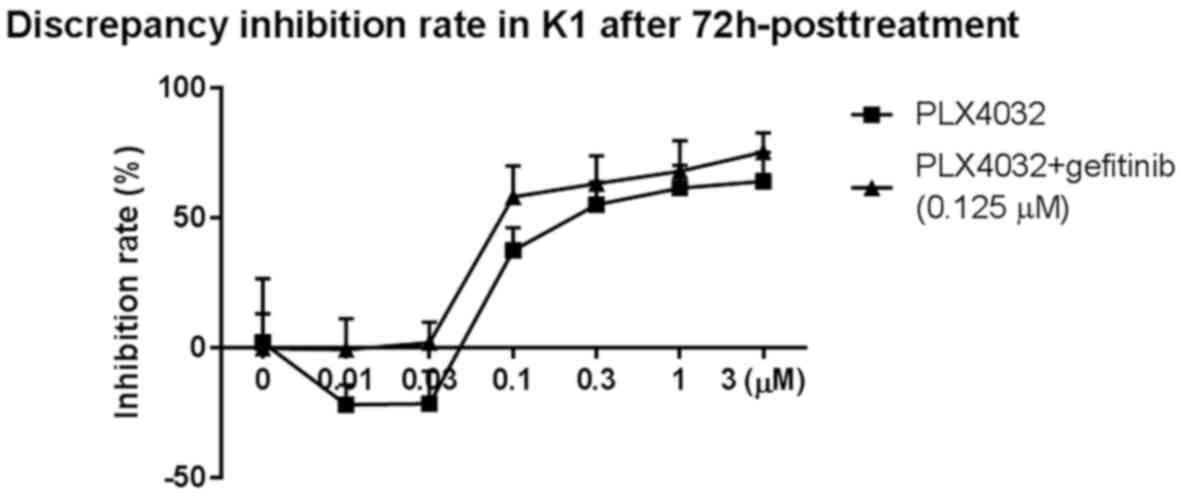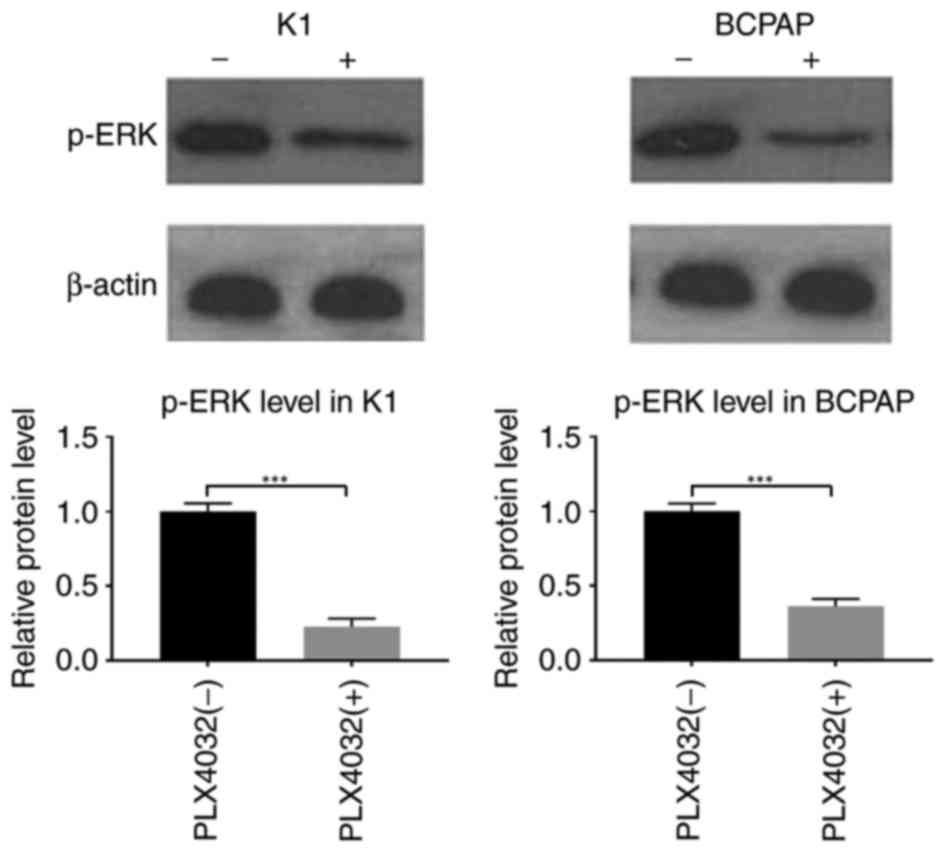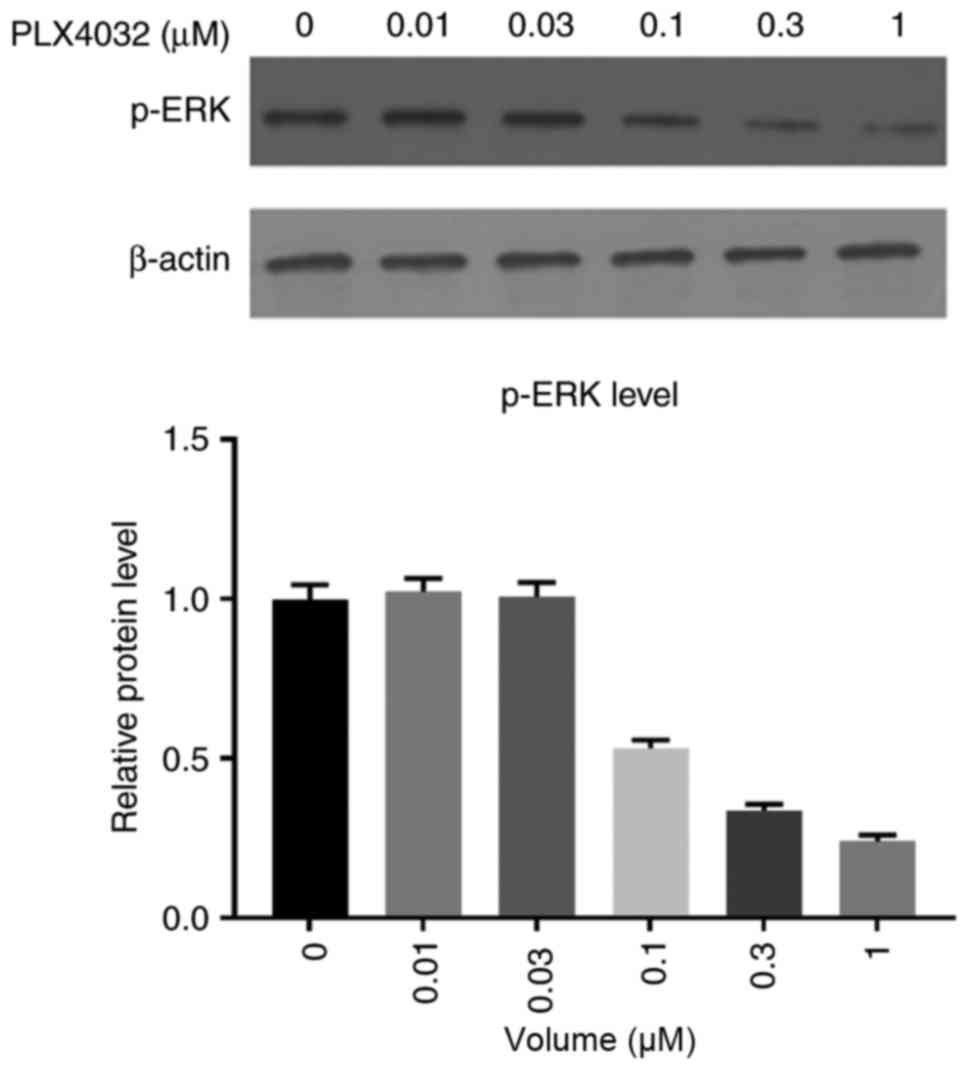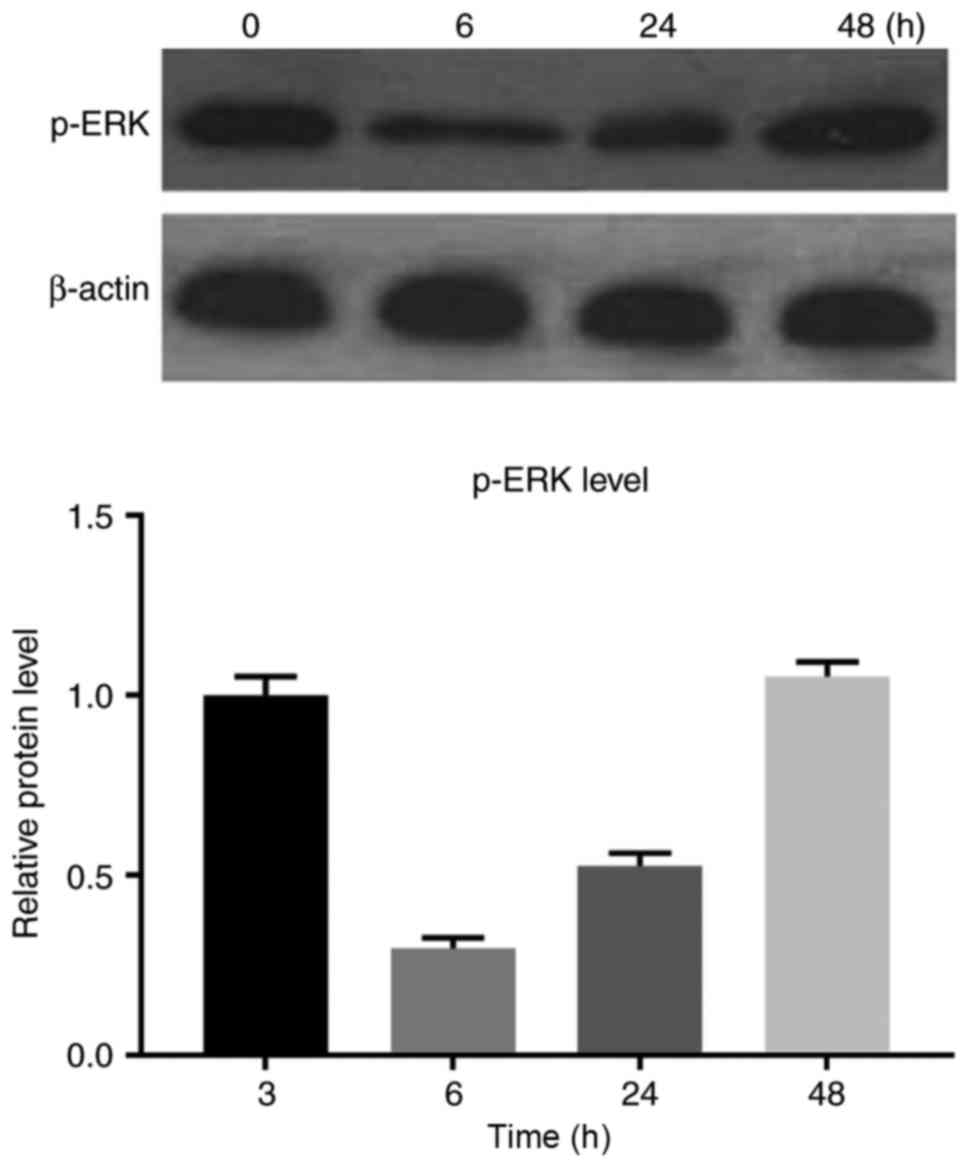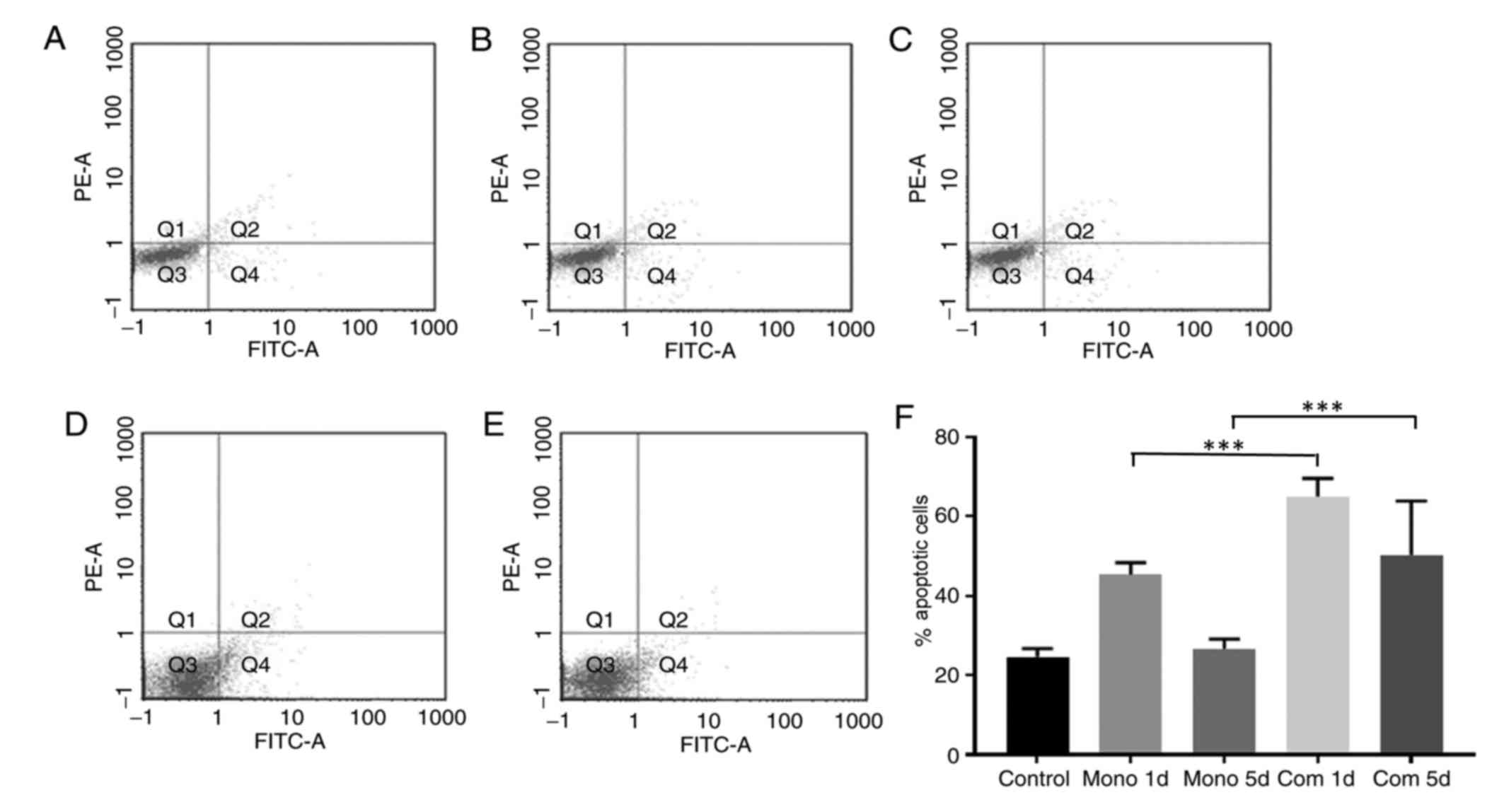EGFR inhibition enhances the antitumor efficacy of a selective BRAF V600E inhibitor in thyroid cancer cell lines
- Authors:
- Published online on: February 21, 2018 https://doi.org/10.3892/ol.2018.8093
- Pages: 6763-6769
Abstract
Introduction
The incidence of thyroid cancer has rapidly increased over the past few years and thyroid cancer is now the fifth most common cancer type diagnosed in women in the USA (1,2). Papillary thyroid cancer (PTC) accounts for >80% of thyroid tumors and is associated with a relatively favorable prognosis subsequent to surgical treatment. However, PTC tumors that are difficult to resect and those that metastasize remain a challenge to treat with long-term success (3–5). Examples of such challenging cases include recurrent thyroid cancer and anaplastic thyroid cancer (ATC) (6). It has been reported that recurrence is experienced in 20–30% of patients with thyroid cancer within the first 20 years post-surgery (7). Radioactive iodine and thyrotropin-suppressive therapies are used to treat these patients; however, persistent metastasis and dedifferentiation despite these treatments associate them with poor prognoses (4,5). The 10-year survival rate for patients with recurrent disease is only 10%, and this value has remained unchanged for numerous years due to the limited progress in the available treatments for recurrent thyroid cancer (8).
BRAF mutations have been identified in a variety of human cancer types, including thyroid cancer, malignant melanoma, ovarian tumors and colorectal cancer (CRC) (9,10). Over 40 BRAF mutations have been reported, the most commonly reported being BRAF V600E, which results from a thymine-to-adenosine transformation at position 1799 in exon 15, causing a valine-to-glutamate substitution at residue 600 in the peptide (11). The activity of the BRAF V600E protein is 10-fold greater than that of the wild-type protein and cannot be regulated appropriately (12). The resulting continuous activation of BRAF V600E activates the mitogen assisted protein kinase (MAPK) signaling pathway and promotes tumor progression (12).
The BRAF V600E mutation occurs in 29–83% cases of PTC, the most common subtype of thyroid cancer, and 24% cases of ATC, the most aggressive and lethal subtype of thyroid cancer (13–15). In addition to acting as a biomarker for diagnosis, the BRAF V600E expression is associated with aggressive and iodine-resistant phenotypes of thyroid cancer (14). It has been reported that thyroid cancers harboring the BRAF V600E mutation tend to exhibit other factors indicative of a poor prognosis, including extra-thyroidal extension, lymph node metastasis, advanced stage, iodine-131 resistance, recurrent disease and distant metastasis (16–21). Even in papillary thyroid microcarcinoma (with diameters <1 cm), the BRAF V600E mutation is associated with extra-thyroidal extension and lymph node metastasis (22,23).
The BRAF V600E protein has been investigated as a therapeutic target in a number of studies and various BRAF V600E inhibitors have been identified (24–26). Sorafenib is a first-generation BRAF V600E inhibitor. However, the mechanism by which the effect of sorafenib is mediated remains unclear due to its ability to inhibit multiple kinases (27,28). Vemurafenib and dabrafenib are selective BRAF V600E inhibitors, which have demonstrated therapeutic activity in phase 1 and 2 clinical trials in patients with BRAF V600E-mutation-induced metastatic melanoma, and they have been approved by the Food and Drug Administration (29). However, these inhibitors are unable to efficiently suppress the progression of other types of cancer and resistance to the inhibitors developed within 6–7 months, even in melanoma (30,31). In CRC, endothelial growth factor receptor (EGFR)-mediated re-proliferation serves an essential role in the resistance to BRAF inhibition (32). It has been reported that overexpression of EGFR results in constitutive activation of the MAPK signaling pathway and promotes cancer cell proliferation, even during treatment with selective BRAF V600E inhibitors (32). In the present study, BRAF V600E was inhibited and downregulation of EGFR was induced in PTC cell lines to determine whether this combined strategy was able to efficiently block cancer cell proliferation, and if it may be a potential novel treatment for thyroid cancer.
Materials and methods
Cell lines and reagents
The K1 and BCPAP cell lines were purchased from Sigma-Aldrich (Merck KGaA Darmstadt, Germany). K1 and BCPAP are papillary thyroid cancer cell lines, and K1 cells are a derivative of the GLAG-66 cell line (33). Both cell lines were passaged for <3 months from stocks generated from the first or second passage of the original cells. The mutation status of these cell lines is reported in Table I. BCPAP cells were maintained in Dulbecco's modified Eagle medium with 10% fetal bovine serum (FBS), and K1 cells were maintained in RPMI-1640 supplemented with 10% FBS. The cells were maintained at 37°C in a humidified incubator with 5% carbon dioxide. The BRAF V600E-selective inhibitor PLX4032 was obtained from Plexxikon, Inc. (Berkeley, CA, USA) and the EGFR-selective inhibitor, gefitinib, was obtained from Roche Diagnostics (Basel, Switzerland). Inhibitors were dissolved in DMSO and the stock solutions were stored at −20°C.
Cellular proliferation assays
Proliferation of K1 and BCPAP cells was evaluated using the MTT assay (Sigma-Aldrich; Merck KGaA). Cells were plated in 96-well microtiter plates at a density of 3×103 cells/well in a volume of 180 µl DMEM with FBS. PLX4032 with or without gefitinib was diluted in media containing 1% DMSO at 10X the final assay concentrations (PLX4032: 0.01, 0.03, 0.1, 0.3, 1 and 3 µM; gefitinib: 0.125 µM). After 24 h of culture, 20 µl each drug dilution was added in triplicate to separate wells. Cells were assayed for proliferation at 24, 48, 72, 96 and 120-h time points. The percentage of inhibition was calculated using the following formula: 100-(mean absorbance of experimental wells/mean absorbance of control wells) ×100. The half maximal inhibitory concentration (IC50) values were determined by calculating the regression of plots produced from the logarithms of concentration vs. percentage inhibition, using XLfit software (version 4.2; ID Business Solutions Ltd., Guildford, UK).
Western blot analysis
Cells were seeded at 70–75% confluence in 6-well plates, 1 day prior to drug treatment. Cells were cultured at the aforementioned drug concentrations and times at 37°C with 5% CO2, and were harvested and lysed in 1X cell lysis buffer (Cell Signaling Technology, Inc., Danvers, MA, USA). After a 20-min incubation on ice, the lysates were centrifuged at 12,000 × g for 15 min at 4°C to clear insoluble debris. The protein concentrations of the lysates were then determined with a BCA kit (Invitrogen; Thermo Fisher Scientific, Inc., Waltham, MA, USA), and equal amounts of total protein from cell lysates and tumor lysates (10 µg for each lane) were resolved on 4–12% NuPage gradient polyacrylamide gels (Invitrogen; Thermo Fisher Scientific, Inc.) before they were blotted onto polyvinylidene fluoride membrane (GE Healthcare Life Sciences, Little Chalfont, UK). The membranes were first blocked with 5% dry fat free milk for 1 h at room temperature and washed twice with Tris-Buffered Saline containing 0.1% Tween-20 (Affymetrix, Inc.; Thermo Fisher Scientific, Inc.). The blocked membranes were probed with rabbit polyclonal antibodies against human phosphorylated-extracellular regulated kinase (p-ERK1/2) (Cell Signaling Technology, Inc.; cat no. 4370S; dilution, 1:1,000), ERK1/2 (Sigma-Aldrich; Merck KGaA; cat no. M5670; dilution, 1:1,000), β-actin (cat no. sc-130656; Santa Cruz Biotechnology, Inc., Dallas, TX, USA; dilution, 1:2,000) and incubated for 2 h at room temperature. Followed by incubation for 1 h at room temperature with horseradish peroxidase-conjugated goat anti-rabbit IgG secondary antibody (cat no. sc-2004; dilution, 1:5,000; Santa Cruz Biotechnology, Inc.). A chemiluminescent signal was generated using Amersham ECL Plus Western Blotting Detection reagents (GE Healthcare, Chicago, IL, USA) and detected with a Fujifilm LAS-3000 imager (Fujifilm, Tokyo, Japan). The densitometry was performed using Multi Gauge 3.0 software (Fujifilm).
Flow cytometry
Cells were seeded in 6-well plates at 4×105 cells/well and incubated for 24 h prior to treatment with PLX4032 and/or gefitinib. A total of five treatment groups were analyzed: PLX4032 monotreatment for 1 day; PLX4032 monotreatment for 5 days; PLX4032 combined with gefitinib for 1 day; and PLX4032 combined with gefitinib for 5 days. The concentrations of PLX4032 and gefitinib were 0.206 and 0.125 µM, respectively. Untreated cells were used as a control group. Apoptosis was evaluated by measuring the exposure of phosphatidylserine on cell membranes using Annexin V-FITC apoptosis detection kits (Sigma-Aldrich; Merck KGaA). Following the treatments, cell pellets were resuspended in a solution containing 5 µg/ml propidium iodide and 1 µg/ml Annexin V-fluorescein isothiocyanate for 15 min at room temperature in darkness. Subsequently, the cells were assessed by a flow cytometer equipped with CellQuest 5.1 software (BD Biosciences, Franklin Lakes, NJ, USA).
Statistical methods
GraphPad Prism 7.0 software (GraphPad Software, Inc., La Jolla, CA, USA) was used to analyze all data and the results are presented as the mean ± standard error. Significant differences were determined by one-way analysis of variance followed by Tukey's post hoc test. P<0.05 was considered to indicate a statistically significant difference.
Results
Co-treated with gefitinib and PLX4032 had a stronger anti-proliferation efficacy
To evaluate the anti-proliferation efficacy of PLX4032, the IC50 values of PLX4032 were obtained for K1 and BCPAP cells using an MTT assay at different time-points. Both cell lines were most sensitive to PLX4032 at 72 h. The IC50 in K1 cells (0.550 µM) was compared with BCPAP cells (1.772 µM) (Fig. 1). It has been reported that the IC50 of gefitinib is 0.125 µM for other cancer cell lines (32). The IC50 for PLX4032 in K1 cells co-treated with gefitinib was determined at the 72-h time-point. The combination suppressed proliferation more effectively than PLX4032 treatment alone, resulting in a lower IC50 of 0.206 µM (Fig. 2).
Reactivation of the MAPK signaling pathway was found in papillary thyroid cancer cell lines
To investigate the mechanism of inhibitor resistance, the activity of the MAPK signaling pathway was examined. ERK is a key enzyme in this pathway; therefore, the phosphorylation of ERK was measured in order to evaluate MAPK pathway activity. K1 and BCPAP cells were treated with PLX4032 (K1: 0.2 µM; BCPAP: 1.772 µM) for 12 h. Western blot analyses indicated that p-ERK levels were low in the PLX4032-treated groups compared with the control groups, suggesting that MAPK activity was suppressed by PLX4032 (Fig. 3). K1 was more sensitive to PLX4032; therefore K1 was used in the following experiments. Treatment of K1 cells with varying concentrations (0, 0.01, 0.03, 0.1, 0.3 and 1 µM) of PLX4032 demonstrated that this inhibition of MAPK was dose-dependent (Fig. 4). Subsequently, K1 cells were treated with 0.550 µM PLX4032 and the p-ERK levels were examined at different time points (0, 6, 24 and 48 h). The lowest level of p-ERK was detected at the 6 h time-point, after which the p-ERK levels increased, indicating reactivation of the MAPK signaling pathway (Fig. 5).
Co-treated with gefitinib and PLX4032 promoted apoptosis
Flow cytometric analysis of apoptosis indicated that apoptosis was elevated in cells cultured with PLX4032 for 1 day compared with cells in the control group. However, apoptosis in the treated group decreased from day 1 to 5, indicating a decrease in the antitumor activity of PLX4032. Apoptosis of K1 cells treated with PLX4032 and gefitinib was significantly elevated compared with the control group and the PLX4032 monotreatment group (P<0.05). In the co-treated group, there was no significant difference between the level of apoptosis on days 1 and 5, which indicates continued suppression over time (Fig. 6). Additionally, the combined treatment with an EGFR inhibitor was able to increase the antitumor efficacy of BRAF V600E inhibitors and suppress drug resistance in PTC cells (Fig. 7).
Discussion
The BRAF V600E mutation has been reported in numerous types of cancer, including thyroid cancer, CRC and melanoma (9,10). BRAF V600E is an oncogene, and serves an important role in tumorigenesis and cancer progression. The protein encoded by BRAF V600E is >10-fold more active compared with the wild-type protein and is not regulated by normal feedback mechanisms (12). BRAF V600E can continuously activate the MAPK signaling pathway, thus promoting tumor proliferation, invasion and metastasis (34). BRAF V600E mutations occur at different rates in different cancer types, but the presence of the mutation consistently indicates poor prognosis (14,15).
BRAF V600E is one of the most common genetic alterations in thyroid cancer. It occurs in 29–83% of PTCs, which comprise >80% of all thyroid tumors (13). PTCs harboring the BRAF V600E mutation have more aggressive clinicopathological features, including extra-thyroidal extension and lymph node metastasis (13–15). Seeing as there are limited therapies for metastatic thyroid cancer, novel treatments are essential to improve disease outcomes for patients exhibiting this mutation. Inhibitors targeting the BRAF V600E protein have been evaluated in clinical trials. However, the inhibitor response depends on the type of cancer (24,25,30). The selective inhibitor PLX4032 has exhibited beneficial therapeutic effects on metastatic melanoma, but no effect on colon or thyroid cancers (32). Numerous mechanisms to account for the resistance of thyroid cancer to BRAF inhibition have been suggested, including the following: Activation of the RAF/MEK/ERK pathway caused by BRAF alternative splicing; activation of the phosphoinositide 3-kinase (PI3K)/AKT serine/threonine kinase (AKT) pathway through hepatocyte growth factor receptor; autocrine neuregulin 1-mediated human epidermal growth factor receptor 3 activation of the PI3K/AKT and RAS/RAF/MEK/ERK pathways; autocrine interleukin-6-mediated activation of the janus kinase/signal transducer and activator of transcription 3 and RAS/RAF/MEK/ERK pathways, and increased autophagy (31,35–37).
In CRC, it has been reported that EGFR overexpression promotes tumor proliferation (32). The present study determined whether PLX4032 combined with the EGFR inhibitor, gefitinib, was able to suppress thyroid cancer cell proliferation. Co-treatment with gefitinib significantly increased the antitumor activity of PLX4032. Frasca et al (38) reported that co-treatment with PLX4032 was able to decrease the IC50 of gefitinib. These data indicate that PLX4032 (vemurafenib) and gefitinib are able to produce synergistic effects. Vemurafenib and gefitinib are safe for use in patients, and therapeutic regimen combining BRAF and MAPK inhibitors may result in greater efficacy and fewer side effects.
To further understand the molecular mechanism of BRAF inhibitor resistance, activity of the MAPK pathway was examined. In thyroid cancer cell lines, the MAPK pathway was suppressed by PLX4032. This inhibition was the most effective after 6 h of treatment. MAPK activity gradually increased after 6 h, indicating that the pathway was reactivated. Danysh et al (39) reported that treatment of PTC cell lines with a selective BRAF inhibitor for 5 months led to the acquisition of resistance to the inhibitor through a spontaneous KRAS G12D mutation. Thus, cancer cells can acquire short-term and long-term resistance to BRAF inhibition. In the present study, combined treatment with gefitinib and PLX4032 continuously suppressed the MAPK pathway, indicating that EGFR serves an important role in the resistance of cells to BRAF inhibition.
As MAPK signaling has an established association with apoptosis, the survival of PLX4032-treated thyroid cancer cells was quantified. Flow cytometry demonstrated that PLX4032 treatment initially increased apoptosis, but this effect declined after 5 days of treatment, indicating that the effect of PLX4032 on cell survival was short-term. Combined treatment with gefitinib significantly increased apoptosis and prolonged this effect (Fig. 7).
In conclusion, PTC cells harboring a BRAF V600E mutation may become resistant to selective BRAF inhibition through reactivation of the EGFR/MAPK pathway. Combined treatment with an EGFR inhibitor is able to increase the antitumor efficacy of BRAF V600E inhibitors and suppress drug resistance in PTC cells.
Acknowledgements
Not applicable.
Funding
No funding was received.
Availability of data and materials
All data that were generated or analyzed in this study are included in this manuscript.
Authors' contributions
YJ and CZ conceived and designed the study. CH and YY conducted the experiments. XZ and YL performed the statistical analysis; MG interpreted the statistical analysis, reviewed and made final approval of the version to be published. All authors read and approved the manuscript.
Ethics approval and consent to participate
Not applicable.
Consent for publication
Not applicable.
Competing interests
The authors declare that they have no competing interests.
References
|
Siegel RL, Miller KD and Jemal A: Cancer statistics. CA Cancer J Clin. 67:7–30. 2017. View Article : Google Scholar : PubMed/NCBI | |
|
Davies L and Welch HG: Increasing incidence of thyroid cancer in the United States, 1973–2002. JAMA. 295:2164–2167. 2006. View Article : Google Scholar : PubMed/NCBI | |
|
Tuttle RM, Haddad RI, Ball DW, Byrd D, Dickson P, Duh QY, Ehya H, Haymart M, Hoh C, Hunt JP, et al: Thyroid carcinoma, version 2.2014. J Natl Compr Canc Netw. 12:1671–1680. 2014. View Article : Google Scholar : PubMed/NCBI | |
|
Antonelli A, Fallahi P, Ferrari SM, Carpi A, Berti P, Materazzi G, Minuto M, Guastalli M and Miccoli P: Dedifferentiated thyroid cancer: A therapeutic challenge. Biomed Pharmacother. 62:559–563. 2008. View Article : Google Scholar : PubMed/NCBI | |
|
Schlumberger M, Brose M, Elisei R, Leboulleux S, Luster M, Pitoia F and Pacini F: Definition and management of radioactive iodine-refractory differentiated thyroid cancer. Lancet Diabetes Endocrinol. 2:356–358. 2014. View Article : Google Scholar : PubMed/NCBI | |
|
Haddad RI, Lydiatt WM, Ball DW, Busaidy NL, Byrd D, Callender G, Dickson P, Duh QY, Ehya H, Haymart M, et al: Anaplastic thyroid carcinoma, version 2.2015. J Natl Compr Canc Netw. 13:1140–1150. 2015. View Article : Google Scholar : PubMed/NCBI | |
|
Xing M, Westra WH, Tufano RP, Cohen Y, Rosenbaum E, Rhoden KJ, Carson KA, Vasko V, Larin A, Tallini G, et al: BRAF mutation predicts a poorer clinical prognosis for papillary thyroid cancer. J Clin Endocrinol Metab. 90:6373–6379. 2005. View Article : Google Scholar : PubMed/NCBI | |
|
Durante C, Haddy N, Baudin E, Leboulleux S, Hartl D, Travagli JP, Caillou B, Ricard M, Lumbroso JD, De Vathaire F and Schlumberger M: Long-term outcome of 444 patients with distant metastases from papillary and follicular thyroid carcinoma: Benefits and limits of radioiodine therapy. J Clin Endocrinol Metab. 91:2892–2899. 2006. View Article : Google Scholar : PubMed/NCBI | |
|
Davies H, Bignell GR, Cox C, Stephens P, Edkins S, Clegg S, Teague J, Woffendin H, Garnett MJ, Bottomley W, et al: Mutations in the BRAF gene in human cancer. Nature. 417:949–954. 2002. View Article : Google Scholar : PubMed/NCBI | |
|
McCubrey JA, Steelman LS, Chappell WH, Abrams SL, Wong EW, Chang F, Lehmann B, Terrian DM, Milella M, Tafuri A, et al: Roles of the Raf/MEK/ERK pathway in cell growth, malignant transformation and drug resistance. Biochim Biophys Acta. 1773:1263–1284. 2007. View Article : Google Scholar : PubMed/NCBI | |
|
Garnett MJ and Marais R: Guilty as charged: B-RAF is a human oncogene. Cancer Cell. 6:313–319. 2004. View Article : Google Scholar : PubMed/NCBI | |
|
Tsai J, Lee JT, Wang W, Zhang J, Cho H, Mamo S, Bremer R, Gillette S, Kong J, Haass NK, et al: Discovery of a selective inhibitor of oncogenic B-Raf kinase with potent antimelanoma activity. Proc Natl Acad Sci USA. 105:pp. 3041–3046. 2008; View Article : Google Scholar : PubMed/NCBI | |
|
Kim KH, Kang DW, Kim SH, Seong IO and Kang DY: Mutations of the BRAF gene in papillary thyroid carcinoma in a Korean population. Yonsei Med J. 45:818–821. 2004. View Article : Google Scholar : PubMed/NCBI | |
|
Namba H, Nakashima M, Hayashi T, Hayashida N, Maeda S, Rogounovitch TI, Ohtsuru A, Saenko VA, Kanematsu T and Yamashita S: Clinical implication of hot spot BRAF mutation, V599E, in papillary thyroid cancers. J Clin Endocrinol Metab. 88:4393–4397. 2003. View Article : Google Scholar : PubMed/NCBI | |
|
Xing M: BRAF mutation in thyroid cancer. Endocr Relat Cancer. 12:245–262. 2005. View Article : Google Scholar : PubMed/NCBI | |
|
Sherman SI, Angelos P, Ball DW, Beenken SW, Byrd D, Clark OH, Daniels GH, Dilawari RA, Ehya H, Farrar WB, et al: Thyroid carcinoma. J Natl Compr Canc Netw. 3:404–457. 2005.PubMed/NCBI | |
|
DeGroot LJ, Kaplan EL, McCormick M and Straus FH: Natural history, treatment, and course of papillary thyroid carcinoma. J Clin Endocrinol Metab. 71:414–424. 1990. View Article : Google Scholar : PubMed/NCBI | |
|
Mazzaferri EL and Kloos RT: Clinical review 128: Current approaches to primary therapy for papillary and follicular thyroid cancer. J Clin Endocrinol Metab. 86:1447–1463. 2001. View Article : Google Scholar : PubMed/NCBI | |
|
Sherman SI, Brierley JD, Sperling M, Ain KB, Bigos ST, Cooper DS, Haugen BR, Ho M, Klein I, Ladenson PW, et al: Prospective multicenter study of thyroid carcinoma treatment: Initial analysis of staging and outcome. National thyroid cancer treatment cooperative study registry group. Cancer. 83:1012–1021. 1998. View Article : Google Scholar : PubMed/NCBI | |
|
Tanaka K, Sonoo H, Hirono M, Ohkubo S, Nomura T, Ikeda M, Nakajima K and Kurebayashi J: Retrospective analysis of predictive factors for recurrence after curatively resected papillary thyroid carcinoma. Surg Today. 35:714–719. 2005. View Article : Google Scholar : PubMed/NCBI | |
|
Mazzaferri EL and Jhiang SM: Long-term impact of initial surgical and medical therapy on papillary and follicular thyroid cancer. Am J Med. 97:418–428. 1994. View Article : Google Scholar : PubMed/NCBI | |
|
Lin KL, Wang OC, Zhang XH, Dai XX, Hu XQ and Qu JM: The BRAF mutation is predictive of aggressive clinicopathological characteristics in papillary thyroid microcarcinoma. Ann Surg Oncol. 17:3294–3300. 2010. View Article : Google Scholar : PubMed/NCBI | |
|
Lee X, Gao M, Ji Y, Yu Y, Feng Y, Li Y, Zhang Y, Cheng W and Zhao W: Analysis of differential BRAF(V600E) mutational status in high aggressive papillary thyroid microcarcinoma. Ann Surg Oncol. 16:240–245. 2009. View Article : Google Scholar : PubMed/NCBI | |
|
Brose MS, Cabanillas ME, Cohen EEW, Wirth L, Sherman SI, Riehl T, Yue H and Sherman E: An open label, multi-center phase 2 study of the BRAF inhibitor vemurafenib in patients with metastatic or unresectable papillary thyroid cancer (PTC) positive for the BRAF V600 mutation and resistant to radioactive iodine (NCT01286753, NO25530). Eur J Cancer. 49 Suppl:S132013. | |
|
Dadu R, Shah K, Busaidy NL, Waguespack SG, Habra MA, Ying AK, Hu MI, Bassett R, Jimenez C, Sherman SI and Cabanillas ME: Efficacy and tolerability of vemurafenib in patients with BRAF(V600E)-positive papillary thyroid cancer: M.D. Anderson cancer center off label experience. J Clin Endocrinol Metab. 100:E77–E81. 2015. View Article : Google Scholar : PubMed/NCBI | |
|
Falchook GS, Millward M, Hong D, Naing A, Piha-Paul S, Waguespack SG, Cabanillas ME, Sherman SI, Ma B, Curtis M, et al: BRAF inhibitor dabrafenib in patients with metastatic BRAF-mutant thyroid cancer. Thyroid. 25:71–77. 2015. View Article : Google Scholar : PubMed/NCBI | |
|
Murphy DA, Makonnen S, Lassoued W, Feldman MD, Carter C and Lee WM: Inhibition of tumor endothelial ERK activation, angiogenesis, and tumor growth by sorafenib (BAY43-9006). Am J Pathol. 169:1875–1885. 2006. View Article : Google Scholar : PubMed/NCBI | |
|
Lyons JF, Wilhelm S, Hibner B and Bollag G: Discovery of a novel Raf kinase inhibitor. Endocr Relat Cancer. 8:219–225. 2001. View Article : Google Scholar : PubMed/NCBI | |
|
Sosman JA, Kim KB, Schuchter L, Gonzalez R, Pavlick AC, Weber JS, McArthur GA, Hutson TE, Moschos SJ, Flaherty KT, et al: Survival in BRAF V600-mutant advanced melanoma treated with vemurafenib. N Engl J Med. 366:707–714. 2012. View Article : Google Scholar : PubMed/NCBI | |
|
Hyman DM, Puzanov I, Subbiah V, Faris JE, Chau I, Blay JY, Wolf J, Raje NS, Diamond EL, Hollebecque A, et al: Vemurafenib in multiple nonmelanoma cancers with BRAF V600 mutations. N Engl J Med. 373:726–736. 2015. View Article : Google Scholar : PubMed/NCBI | |
|
Montero-Conde C, Ruiz-Llorente S, Dominguez JM, Knauf JA, Viale A, Sherman EJ, Ryder M, Ghossein RA, Rosen N and Fagin JA: Relief of feedback inhibition of HER3 transcription by RAF and MEK inhibitors attenuates their antitumor effects in BRAF-mutant thyroid carcinomas. Cancer Discov. 3:520–533. 2013. View Article : Google Scholar : PubMed/NCBI | |
|
Prahallad A, Sun C, Huang S, Di Nicolantonio F, Salazar R, Zecchin D, Beijersbergen RL, Bardelli A and Bernards R: Unresponsiveness of colon cancer to BRAF(V600E) inhibition through feedback activation of EGFR. Nature. 483:100–103. 2012. View Article : Google Scholar : PubMed/NCBI | |
|
Ribeiro FR, Meireles AM, Rocha AS and Teixeira MR: Conventional and molecular cytogenetics of human non-medullary thyroid carcinoma: Characterization of eight cell line models and review of the literature on clinical samples. BMC Cancer. 8:3712008. View Article : Google Scholar : PubMed/NCBI | |
|
Mercer KE and Pritchard CA: Raf proteins and cancer: B-Raf is identified as a mutational target. Biochim Biophys Acta. 1653:25–40. 2003.PubMed/NCBI | |
|
Baitei EY, Zou M, Al-Mohanna F, Collison K, Alzahrani AS, Farid NR, Meyer B and Shi Y: Aberrant BRAF splicing as an alternative mechanism for oncogenic B-Raf activation in thyroid carcinoma. J Pathol. 217:707–715. 2009. View Article : Google Scholar : PubMed/NCBI | |
|
Byeon HK, Na HJ, Yang YJ, Kwon HJ, Chang JW, Ban MJ, Kim WS, Shin DY, Lee EJ, Koh YW, et al: c-Met-mediated reactivation of PI3K/AKT signaling contributes to insensitivity of BRAF(V600E) mutant thyroid cancer to BRAF inhibition. Mol Carcinog. 55:1678–1687. 2016. View Article : Google Scholar : PubMed/NCBI | |
|
Sos ML, Levin RS, Gordan JD, Oses-Prieto JA, Webber JT, Salt M, Hann B, Burlingame AL, McCormick F, Bandyopadhyay S and Shokat KM: Oncogene mimicry as a mechanism of primary resistance to BRAF inhibitors. Cell Rep. 8:1037–1048. 2014. View Article : Google Scholar : PubMed/NCBI | |
|
Frasca F, Vella V, Nicolosi ML, Messina RL, Gianì F, Lotta S, Vigneri P, Regalbuto C and Vigneri R: Thyroid cancer cell resistance to gefitinib depends on the constitutive oncogenic activation of the ERK pathway. J Clin Endocrinol Metab. 98:2502–2512. 2013. View Article : Google Scholar : PubMed/NCBI | |
|
Danysh BP, Rieger EY, Sinha DK, Evers CV, Cote GJ, Cabanillas ME and Hofmann MC: Long-term vemurafenib treatment drives inhibitor resistance through a spontaneous KRAS G12D mutation in a BRAF V600E papillary thyroid carcinoma model. Oncotarget. 7:30907–30923. 2016. View Article : Google Scholar : PubMed/NCBI |



